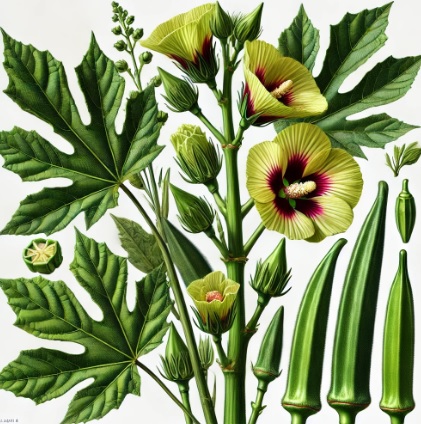Lady's fingers (Hibiscus esculentus), commonly known as okra or lady's finger, is a flowering plant widely cultivated for its edible pods. Native to Africa and the Middle East, it is now grown globally for its culinary and nutritional value. The plant is valued for its distinctive, elongated seed pods and its ornamental appeal, especially in tropical and subtropical gardens.
Botanical Classification:
Family: Malvaceae
Genus: Hibiscus
Species: H. esculentus
Common Names: Okra, Lady's Finger, Gumbo
Plant Characteristics:
Size: The plant typically reaches a height of 1 to 2.5 meters (3 to 8 feet) and has a similar spread.
Leaves: The leaves are large, lobed, and have a palmate arrangement. They are usually green, though they may have red or purple tints in some varieties.
Flowers: Hibiscus esculentus produces large, funnel-shaped flowers that are usually yellow with a red or purple center. The flowers are about 5-7 cm (2-3 inches) in diameter and bloom from summer to fall.
Fruit: The plant bears elongated, green seed pods, known as okra or lady's fingers. These pods are harvested while still immature and are used in various culinary dishes.
Chemical Composition and Structure:
The okra pods contain several bioactive compounds:
Flavonoids: Such as quercetin and kaempferol, which provide antioxidant and anti-inflammatory benefits.
Vitamins: Rich in vitamins A, C, and K, as well as several B vitamins.
Minerals: Includes magnesium, potassium, and calcium, contributing to its nutritional profile.
Polysaccharides: Particularly mucilage, which has soothing, moisturizing, and thickening properties.
Antioxidants: Various antioxidants contribute to the plant’s health benefits and protect against oxidative stress.
Uses and Benefits:
Culinary: The pods are widely used in cooking, particularly in dishes such as gumbo, soups, and stews. They are valued for their unique texture and flavor.
Nutritional: Okra is a nutritious vegetable that provides essential vitamins, minerals, and dietary fiber, supporting overall health and digestion.
Cosmetic: Okra extract is used in skincare products for its hydrating, soothing, and antioxidant properties. It helps to maintain skin moisture and elasticity.
Medicinal: Traditionally used in various cultures for its potential benefits in managing blood sugar levels, digestive health, and inflammation.
Applications:
Culinary: Incorporated into recipes as a vegetable, often used in soups, stews, and stir-fries. It is also pickled or used as a thickening agent in dishes.
Cosmetics: Found in skincare products such as creams, masks, and serums for its hydrating and soothing effects.
Nutritional Supplements: Used in dietary supplements and functional foods aimed at providing health benefits and supporting overall well-being.
Environmental and Safety Considerations:
Environmental Impact: Hibiscus esculentus is a hardy plant that thrives in warm climates and requires moderate water. It is relatively easy to grow and can be a sustainable addition to gardens and farms.
Safety: Generally safe for consumption and topical use. However, individuals with allergies to plants in the Malvaceae family should be cautious.
INCI:
Skin conditioning agent. It is the mainstay of topical skin treatment as it has the function of restoring, increasing or improving skin tolerance to external factors, including melanocyte tolerance. The most important function of the conditioning agent is to prevent skin dehydration, but the subject is rather complex and involves emollients and humectants that can be added in the formulation.
Synonyms:
CAS: 91723-07-8 EC number 294-510-2
![]() Ladys fingers
Ladys fingers 

